An AAC Journey: From “No to AAC” to “AAC All Day, Every Day” with Desirae Pillay
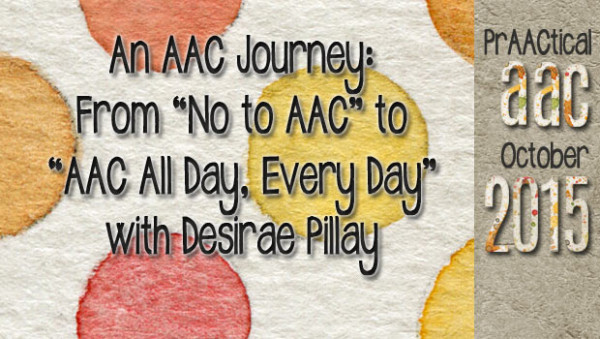
What better way to celebrate AAC Awareness Month than to share AAC stories from around the world? In this post, we welcome Desirae Pillay, who shares a bit about her daughter, Savannah, and their AAC journey. As the mother of a young adult with ASD and cerebral palsy, Desirae has taken what she has learned about AAC and is using it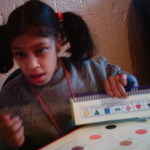 to help others outside of her family. Desirae began her journey with AAC in 2003 when she could not find a qualified AAC specialist to assist her with her daughter. Her experience and informal learning gained her a job for an AT company. When her daughter’s health needs became pressing, she resigned her job and worked part time as a Disability Consultant for various organisations. Desirae recently returned to work as an AT Advisor, where she trains on a range of topics about communication for people with disabilities. Her passion is for families of people with disabilities and fostering good teamwork for the person who uses AAC.
to help others outside of her family. Desirae began her journey with AAC in 2003 when she could not find a qualified AAC specialist to assist her with her daughter. Her experience and informal learning gained her a job for an AT company. When her daughter’s health needs became pressing, she resigned her job and worked part time as a Disability Consultant for various organisations. Desirae recently returned to work as an AT Advisor, where she trains on a range of topics about communication for people with disabilities. Her passion is for families of people with disabilities and fostering good teamwork for the person who uses AAC.
Enjoy this AAC journey from South Africa!
:::::::::::::::::::::::::::::::::::::::::::::::::::::::
From “NO to AAC” to “AAC ALL DAY EVERY DAY” 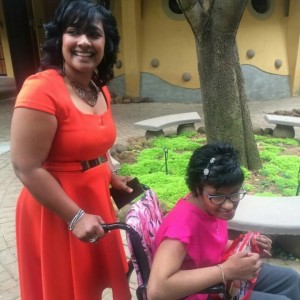
Our journey with AAC began in 2002, when I was first shown visual supports to aid my daughter Savannah, with her communication and behaviour. Savannah was six years old and was diagnosed as a person with cerebral palsy. I was pregnant with our second child, and grappling to accept and understand Savannah as a person with special needs.
At that time in South Africa, a country of many cultures that was still transitioning and learning how to engage about topical issues, speaking about people with special needs was very difficult. Families found themselves at racially integrated special schools, which was still a new concept for many people. Engaging cross culturally was new and then to also engage about our children with special needs was sometimes an added complexity. So my attitude to the visual supports when it was first explained to me was “No, I don’t want this for Savannah.” I felt that it would make us “stick out” even more amongst our family and community, and on that uninformed basis, I rejected the idea.
A year later, unbeknown to me, a friend of mine, arranged for Savannah to receive some funds specifically for the purposes of giving her communication. The lady who I 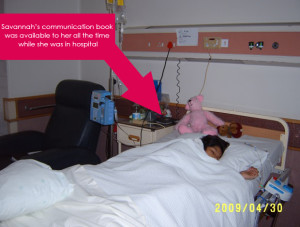 met the previous year about AAC was invited to be at this special presentation ceremony to ‘assist me’ in choosing the right system for Savannah. Against my will, I was now on the road of using AAC. We began with symbol based software to create low tech communication. The software also had the function to be used as a speech generating software. I was told that it would likely take Savannah about 10 years before she might be able to use the program as speech generating software because she was so low functioning.
met the previous year about AAC was invited to be at this special presentation ceremony to ‘assist me’ in choosing the right system for Savannah. Against my will, I was now on the road of using AAC. We began with symbol based software to create low tech communication. The software also had the function to be used as a speech generating software. I was told that it would likely take Savannah about 10 years before she might be able to use the program as speech generating software because she was so low functioning.
Our first problem was that we could not find a single therapist who knew AAC in our area. So, together with Savannah’s then speech 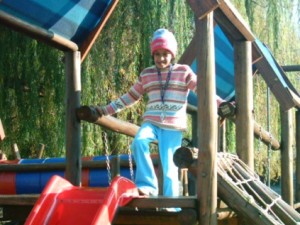 therapist, we began trying different ideas. I labelled our home to teach Savannah object-symbol identification. Savannah had very little concentration, but whenever I needed an object, I would use a symbol/picture to match it to the object. After a few weeks, she began showing interest in what we (my husband and mum included) were doing. I made communication necklaces which my husband, Savannah and I wore. Savannah’s speech therapist made communication necklaces for herself, Savannah’s peers, teachers and other therapist. The therapist encouraged everyone to model communication, all day every day.
therapist, we began trying different ideas. I labelled our home to teach Savannah object-symbol identification. Savannah had very little concentration, but whenever I needed an object, I would use a symbol/picture to match it to the object. After a few weeks, she began showing interest in what we (my husband and mum included) were doing. I made communication necklaces which my husband, Savannah and I wore. Savannah’s speech therapist made communication necklaces for herself, Savannah’s peers, teachers and other therapist. The therapist encouraged everyone to model communication, all day every day.
Using low tech communication boards, about specific topics, we tried to encourage Savannah’s participation in communication. I wish I could say that I was a really good communication partner, but I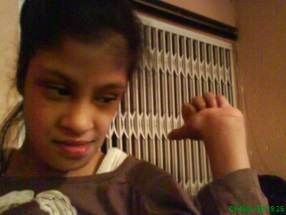 was not. I was too often impatient and overwhelmed, and in those early years, I ignorantly made communication for Savannah ‘work’.
was not. I was too often impatient and overwhelmed, and in those early years, I ignorantly made communication for Savannah ‘work’.
It took Savannah about 8 months before she initiated communication by herself. We were prompting, creating communication opportunities, yet were often feeling that we were forcing her to communicate. But my motivation was renewed when one day she walked into my bedroom, and tapped me. She pointed to the symbol for ‘Friday’. I responded that yesterday was Friday. To which she pointed to the symbols for ‘tuck’ and ‘happy’. I asked while pointing to her symbols “Are you happy that you had tuck on Friday?” She nodded yes, and walked out of the room. I wept with joy, all the while feeling that I must be dreaming.
From that point, Savannah began communicating more often and in different environments. I kept producing boards and eventually a low tech communication book. We did not know about core vocabulary and unfortunately Savannah’s boards did not always have all the words she should have learnt. However, due to what we had achieved with Savannah, the company that sold AAC products offered me a job. It was at this point I learnt about speech generating devices, the use of visual schedules and sequences as well as social stories.
Savannah’s ability to concentrate and her willingness to participate changed dramatically when I loaned 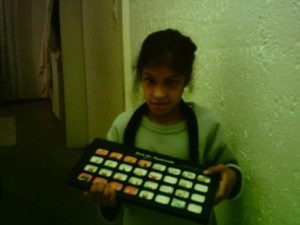 a speech generating device. She learnt turn taking in a conversation as well as participation in literacy activities. It took many months of modelling in natural environments such as “reading” with her sister before bedtime; or “telling” others what she did at Sunday school or “sharing” daily news at school; before Savannah used her device independently. It was about this time that we also learned that Savannah was autistic. This explained her sensory difficulties i.e she did not like our pre-recorded voice on her device. She could tolerate it when it was at a lower volume but not at the louder volume needed for use in a busy class.
a speech generating device. She learnt turn taking in a conversation as well as participation in literacy activities. It took many months of modelling in natural environments such as “reading” with her sister before bedtime; or “telling” others what she did at Sunday school or “sharing” daily news at school; before Savannah used her device independently. It was about this time that we also learned that Savannah was autistic. This explained her sensory difficulties i.e she did not like our pre-recorded voice on her device. She could tolerate it when it was at a lower volume but not at the louder volume needed for use in a busy class.
It was a tough time as I tried to encourage others to accept Savannah’s communication in other environments, while explaining the effect that sensory overload had on her. It was not that she did not want to communicate. She simply could not communicate when there were too many distractions in the environment.
The policy of inclusion of people with special needs in South African culture was still very new, and many biases existed that I did not have the emotional energy to fight. My husband and I faced many tearful days, when Savannah’s communication was not encouraged in all environments. I found that Savannah used her device with little or no opposition at home when the sensory input was low and she was more relaxed.
Unfortunately, we faced opposition from another quarter and that was from some professionals and community leaders. In retrospect, I believe it was a lack of knowledge about people with special needs, a lack of knowledge about technology and sometimes some professionals may have felt intimidated that a family was achieving something that was largely seen as a professional’s job. Fortunately, around the same time as this was unfolding, through my job I met AAC role models and AAC professionals who were encouraging and helpful.
It was their input and advice that kept us motivated. Within 2 years of beginning communication for 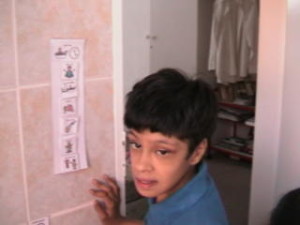 Savannah and against many odds she began using her speech generating software on the PC. I integrated all her boards into a dynamic display set and would leave the PC on all the time with the home page of her communication set open. Again, due to sensory complexities, she resisted the ‘synthetic’ voice until after trying many voices and lowering the volume she sat with me as I worked on the design of her page sets.
Savannah and against many odds she began using her speech generating software on the PC. I integrated all her boards into a dynamic display set and would leave the PC on all the time with the home page of her communication set open. Again, due to sensory complexities, she resisted the ‘synthetic’ voice until after trying many voices and lowering the volume she sat with me as I worked on the design of her page sets.
At this stage she used to spend hours listening to music on the PC. Often I interrupted this to switch to her communication page and used aided language stimulation to give her information about what we would be doing, or what was expected of her. Sometimes I felt that she was not even listening or acknowledging me, and was just waiting for me to leave the room, so that she could return to her music.
I was involved in a non-profit organisation at this time that promoted the needs and created awareness about people with little or no functional speech. Savannah heard Martin Pistorius “speak” with his AAC 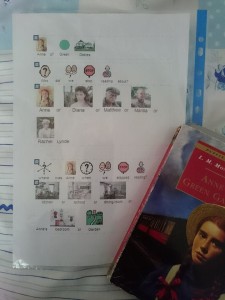 system at one of our events, and later that same week she used her PC to ask “Yoghurt please?” I was stunned for a few moments, and then hurriedly responded without moving “It’s in the fridge. You can get it”. I listened with bated breath as she went to the kitchen, took the yoghurt and a spoon and returned to her PC. I was even more stunned when she said “Thank you” using her PC.
system at one of our events, and later that same week she used her PC to ask “Yoghurt please?” I was stunned for a few moments, and then hurriedly responded without moving “It’s in the fridge. You can get it”. I listened with bated breath as she went to the kitchen, took the yoghurt and a spoon and returned to her PC. I was even more stunned when she said “Thank you” using her PC.
Since that day, Savannah has come a long way. She spent hours exploring her communication page sets, eventually speaking out loud with her own voice. This began with her selecting a symbol, listening to the spoken text and then repeating it verbally. This was unintentional and a very nice surprise for us.
She is now a multi-modal communicator. She uses a laptop with a powerful speech generating software for distance communication such as e-mails. She can’t read or write text, but is extremely proficient and communicative using symbols to share information and get information.
She uses her voice to speak when she is comfortable and the sensory load is at a minimum. When she is out in public, she uses gestures, signs, single spoken words, pointing and sometimes a low tech communication board. She is very dependent on calendars and we also use social stories to help  Savannah to cope during high stress events. She is aware that I write a blog about her and is actively involved in helping me decide on the topic as well as the images that I share.
Savannah to cope during high stress events. She is aware that I write a blog about her and is actively involved in helping me decide on the topic as well as the images that I share.
She survived a scoliosis correction operation, and due to the complexities of her many diagnoses, she has lost her ability to walk independently, and is now a wheel chair user. The build up to the operation as well as all the changes since have been managed through the use of visual supports, ensuring that Savannah had the vocabulary to express her thoughts and feelings; as well as ensuring that everyone involved were willing to use AAC so that Savannah was supported at all times in all environments.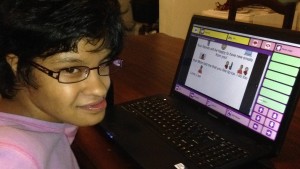
In 2012, Savannah’s then psychologist and I were invited to present at the Information Technologies for Autistic Spectrum Disorder in Valencia, Spain, about the use of technology for Savannah in the South African landscape. The advances in technology and the tireless work being done by our education departments, non-profit organisations, families and individuals for inclusion of people with special needs both in education and in communities has greatly impacted our community of AAC users. We still have a long way to go, but we have also come a long way in 12 years, since I began this journey.
As for Savannah, she is an active part of the plans for her life. She is still learning a nd growing all the time. She can do some chores by herself and recently compiled a list of places that she wanted to learn about. This year she planned her own birthday party, making her own invitations and e-mailing her friends.
nd growing all the time. She can do some chores by herself and recently compiled a list of places that she wanted to learn about. This year she planned her own birthday party, making her own invitations and e-mailing her friends.
For myself, from resisting this path for my daughter, I have not only found a career as an assistive tech
advisor; an advocate for the rights of people with special needs, and a support to other families; I also found my passion. A very Happy AAC Awareness Month from our family to yours.
Edited: See Savannah and Desiree in action here.
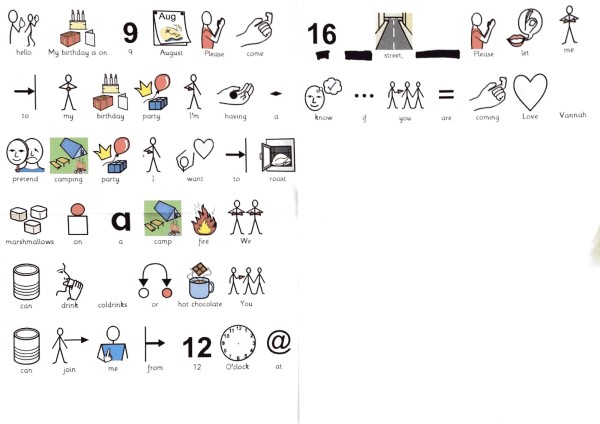
Filed under: PrAACtical Thinking
Tagged With: Desirae Pillay, family, South Africa, teamwork
This post was written by Carole Zangari

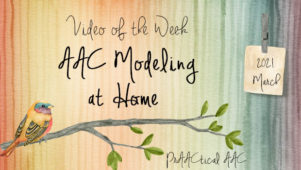
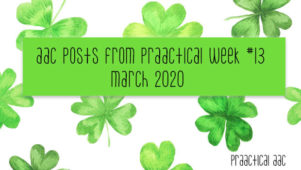
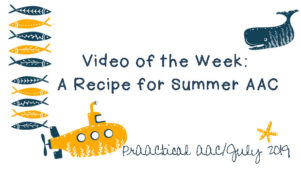
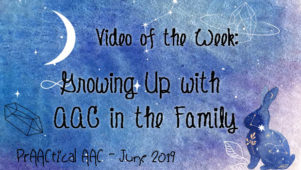
2 Comments
What a magnificent account of this family’s journey. Thank you so much, Desirae and Savannah, for sharing your work on AAC with us. I am particularly encouraged by Savannah’s independent use of the sound on her speech software to practise words out loud, and by her writing. Beautiful work, and makes me hopeful for my son’s efforts too. Thank you.
Genevieve, I read your comment to Savannah and she says thank you. We wish you and your son all the best. We look forward to hearing your story in the future:)